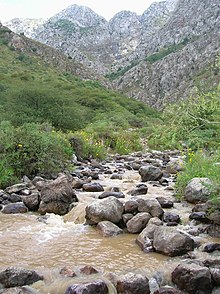You can help expand this article with text translated from the corresponding article in Russian. (October 2022) Click [show] for important translation instructions.
|
Syrdarya–Turkestan State Regional Natural Park (Kazakh: Сырдария-Түркістан өңірлік паркі; Russian: Сырдарья-Туркестанский региональный парк) is a nature preserve in the Turkistan Region of Kazakhstan, which opened on September 5, 2012.[1]

History edit
The Syrdarya–Turkestan State Regional Natural Park was established to protect ecosystems, archaeological sites, and historical-cultural monuments, as well as plants and animal species, some of which are rare or endangered. The park was established in 2010, through the merger of three existing state parks within Arys, Boralday, and Turkistan, and opened on September 5, 2012.[1] The goal was to prioritize the Syr Darya river plain, in order to further protect the wildlife of the area.[1] Additionally the Syr Darya river irrigates many of the agricultural regions in the whole of Central Asia. The area of the park is 120,000 hectares (roughly 296,526 acres). The total area of the park is divided into 4 functional zones – a protected area, an ecological stabilization zone, a zone of tourist and recreational activities, and a zone of limited economic activity.
About 955 species of plants grow in the park, among which 40 species are listed in the Red Book of the Republic of Kazakhstan, a government published book of rare and endangered species within the country. The fauna of the park includes about 382 species of birds and animals. 109 of them are listed in the Red Book of Kazakhstan. One of the attractions of the park is the only nursery in the Republic of Kazakhstan to restore the population of Bactrian deer (also known as Bukhara deer).[2] The park has 25 species of bed bugs, from 8 taxonomy families have been found and studied.[3] The Tutybulak cave is located in within the park and has been studied for the archeology, specifically from the Stone Age.[4]
It has become a site for ecological tourism.[5][6] However in 2022, there have been concerns of the ecotourism causing environmental damage and pollution in the river.[6]
See also edit
References edit
- ^ a b c "Сырдарья-Туркестанский государственный региональный природный парк" [Syrdarya-Turkestan State Regional Natural Park, The History of the Creation of the Regional Park]. Биологический Институт (in Russian). Tomsk State University. Retrieved 2022-10-30.
- ^ Bulatkulova, Saniya (February 6, 2022). "Kazakhstan's Natural Beauty Seen Through Eyes of Zhambyl Photographer". The Astana Times. Regional Non-Profit Organization Guild of Independent Journalists.
- ^ Makhambet, G. K.; Kurbankul, N. N.; Bozshatayeva, G. T.; Ospanova, G. S.; Turabaeva, G. K. (June 14, 2019). "Materials to Study Species Composition, Life Forms and Food Specialization of Hemiptera (Hemiptera) Syrdarya-Turkestan Regional Nature Park". European Journal of Natural History (3). Auezov South Kazakhstan State University: 7–10. ISSN 2073-4972 – via world-science.ru.
- ^ Bulatkulova, Saniya (July 10, 2022). "Kazakh Scientists Discover Stone Age Artifacts in Country's Oldest Cave". The Astana Times. Regional Non-Profit Organization Guild of Independent Journalists.
- ^ "Экологиялық туризм дамып келеді". DalaNews (in Kazakh). 2018-06-07. Retrieved 2022-10-30.
- ^ a b "Сырдария -Түркістан мемлекеттік өңірлік табиғи паркінде сенбілік өтті". turkistan.tv (in Kazakh). October 7, 2022. Retrieved 2022-10-30.